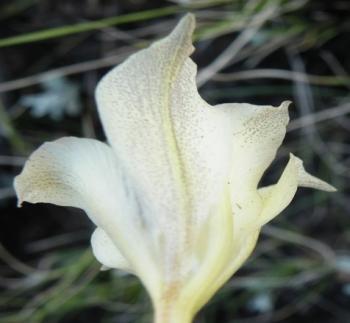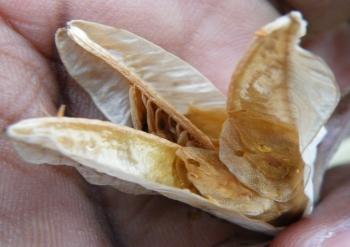Gladiolus longicollis
Gladiolus longicollis Baker
Family: Iridaceae
Common names: honey flower (Eng.); aandblom (Afr.); umbejo (Zulu); khahla-e-nyenyane, kukhurupa (Southern Sotho)
Introduction
Gladiolus longicollis has pale yellow to white, long-tubed, night-blooming flowers that are either uniformly coloured or mottled with brown and have a strong, sweet scent of carnation and cloves.

Description
Description
An attractive, perennial herb, 350–600 mm tall, that is semi-hardy in temperate climates. They grow from rounded, symmetrical corms that are enveloped in several layers of coarse, brownish, fibrous tunics. Leaves 3, only the lowermost with a well-developed blade, about two-thirds as long as the stem.

Flowers in 1-3-flowered spikes, are variously coloured, creamy yellow to white, pink to reddish or light purple with white, contrasting markings, or orange to red. They have a flower tube, 35–110130 mm long, that has nectar at its base. It is known as a grassland plant on the slopes of the Drakensberg, where it is usually tossed about by the wind, and with its flowers furled for most of the day, it is not easy to photograph. The flowers open wide only in the afternoon, when they release a strong sweet fragrance.
Conservation Status
Status
According to the Red List of South African plants, Gladiolus longicollis is assessed as Least Concern (LC), is a widespread species.
Distribution and habitat
Distribution description
Gladiolus longicollis grows in the Eastern Cape and KwaZulu-Natal, and a little into the Free State and the Western Cape. It also occurs in Lesotho. It occurs in grassland, its predominant habitat, usually in low, open grassland.
Derivation of name and historical aspects
History
The genus Gladiolus is derived from the Latin gladius, the diminutive of ‘a sword’, referring to the shape of the leaves. This species is named for its long flower tubes, from the Latin longus, meaning ‘long’ or ‘extended’ and collis, ‘hill’ or ‘mound’, but also ‘neck’ or ‘throat’.
Gladiolus is a genus of perennial, cormous flowering plants in the iris family (Iridaceae). Sometimes called the sword lily, the most widely used English common name for these plants is simply gladiolus (plural gladioli, gladioluses or sometimes gladiolas).
Ecology
Ecology
This species flowers in spring and early summer, but usually only after fire in the preceding winter. The flower is closed for most of the day, starting to open only from about 17h00, earlier if it is cloudy. In the evening it produces a strong, sweet fragrance, which attracts hawk moth that pollinate the flowers.
Seeds are light in weight, with a papery wing, and are dispersed by wind.

Uses
Use
Many African herbalists consider gladioli to be magical medicinal plants, as they are used for the treatment of diarrhoea, colds, dysentery, constipation and also as a booster for patients with low energy levels.
Growing Gladiolus longicollis
Grow
Gladiolus longicollis is seldom cultivated. It is not a showy species, but is an interesting addition to a grassland garden or sunny rockery, and is suitable for containers.
It can be cultivated from corms as well as seeds. It should preferably be planted in light, well-drained, sandy loam soil in full sun. As this is a summer-growing species, plant corms in spring (around September) and give plenty of water all through the growing season. Corms are best planted in open ground, rather than pots, roughly 10 cm deep and 15 cm apart. Avoid the use of inorganic fertilizers, especially those with high nitrogen content. Rather use organic compost or bone meal. The corms can be left in the soil during the winter dormancy period, or lifted and stored in a cool airy place to prevent decay.
When growing from seed, sow in September. Use a well-drained, sterile sowing medium, sow the seeds thinly and cover lightly. The seeds generally germinate well and seedlings appear after 2 to 4 weeks. Water thoroughly all through the growing season. However, flowers will only be produced from the second season onwards.
References
- Alexandersson, R. &Johnson, S.D. 2002. Pollinator-mediated selection on flower-tube length in a hawkmoth-pollinated Gladiolus (Iridaceae). Proceedings of the Royal Society London B 269: 631–636.
- Goldblatt, P. & Manning, J. 1998. Gladiolus in southern Africa. Fernwood Press, Vlaeberg, Cape Town.
Credits
Bathabile Ndlovu
KwaZulu-Natal National Botanical Garden
November 2017
Plant Attributes:
Plant Type: Bulb
SA Distribution: Eastern Cape, KwaZulu-Natal
Soil type: Sandy, Loam
Flowering season: Spring, Early Summer
PH: Acid, Neutral
Flower colour: White, Cream
Aspect: Full Sun
Gardening skill: Average
Special Features:
Horticultural zones








Rate this article
Article well written and informative
Rate this plant
Is this an interesting plant?
Login to add your Comment
Back to topNot registered yet? Click here to register.